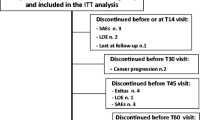Abstract
Objective
The aim of this study was to evaluate the efficacy and adverse reactions of OxyContin hydrochloride controlled release tablets in the treatment of moderate or severe pain in patients with terminal cancer and to observe any improvement on the cancer patients’ quality of life.
Methods
Sixty-eight patients with moderate or severe cancer pain were treated with OxyContin hydrochloride controlled release tablets. The initial dose was 5 mg/12h, or 1/2 that of the standard morphine regimen. During the course of treatment, the dosage was adjusted according to the patients’ condition until the pain completely disappeared or nearly did so. Each patient received a treatment for at least 15 days. At the same time, adverse reactions, the quality of life and scores for the intensity of pain were observed and recorded [1].
Results
The final titrated dosage of OxyContin was as follows: the patients in 30 cases (44.1%) received a dosage of ≤ 30 mg/d, those in 16 cases (23.5%) received a dosage of 31 to 60 mg/d, those in 18 cases (26.5%) received a dosage of 61 to 120 mg/d and those in 4 cases (5.9%) received a dosage of ≥ 120 mg/d. The overall rate of relief from pain was 95.6%, among which the rates of excellent, effective and moderate relief were respectively 39.7%, 48.5% and 7.4%. OxyContin had mild adverse reactions and patients’ quality of life was markedly improved.
Conclusion
OxyContin is effective in treatment of moderate and severe cancer pain. The adverse reactions of OxyContin are mild, and the drug can significantly improve the quality of life of patients with cancer pain.
Similar content being viewed by others
References
Li XM, Liu RQ, Li HY, et al. A retrospective study on analgesia therapy with opiate drugs for dying patients with malignant tumor. Chin J Clin Oncol (Chinese), 2005, 32: 11358–1363.
Kapil R, Nolting A, Roy P, et al. Pharmacokinetic properties of combination OxyContin plus racemic ibuprofen: two randomized, openlabel, crossover studies in healthy adult volunteers. Clin Ther, 2004, 26: 2015–2025.
Sun Y, Gu WP. The guiding principle of cancer pain three-step analgesic ladder. Second edition. Beijing: Peking University Medical Press, 2002. 15–17.
Yu SY, Qiu H, Ma ZS, et al. Effects of sustained release morphine hydrochloride tablets in management of cancer: a survey of 567 patients. Natl Med J China (Chinese), 2004, 86: 450–454.
Sun Y. Medical Oncology. Beijing: People’s Medical Publishing House (PMPH), (Chinese), 2001. 996–997.
Liu H, Wang W, Zheng CZ, et al. The effectws of three step analgesic ladder therapy in 563 cases of cancer pain. Chin J Clin Oncol (Chinese), 2004, 31: 11346–1348.
Yu SY, Jiang ZF, et al. Chinese expert consensus statement on clinical diagnosis and treatment of malignant tumor bone metastasis and bone related diseases. Chinese-German J Clin Oncol, 2010, 9:1–12.
Yu SY, Yan S, Zhang HC, et al. Transdermal fentanyl for management of cancer pain in elderly patients in China. Chinese-German J Clin Oncol, 2004, 3: 85–89.
Nielsen CK, Ross FB, Lotfipour S, et al. OxyContin and morphine have distinctly different pharmacological profiles: radioligand binding and behavioral studies in two rat models of neuropathic pain. Pain, 2007, 132: 289–300.
Hermos JA, Young MM, Gagnon DR, et al. Characterizations of long-term OxyContin/acetaminophen prescriptions in veteran patients. J Clin Psychopharmacol, 2005, 25: 600–604.
Author information
Authors and Affiliations
Corresponding author
Rights and permissions
About this article
Cite this article
Wang, W., OuYang, X., Yu, Z. et al. Clinical application of OxyContin hydrochloride controlled release tablets in treatment of pain suffered from advanced cancer. Chin. -Ger. J. Clin. Oncol. 11, 419–421 (2012). https://doi.org/10.1007/s10330-012-1005-x
Received:
Revised:
Accepted:
Published:
Issue Date:
DOI: https://doi.org/10.1007/s10330-012-1005-x




